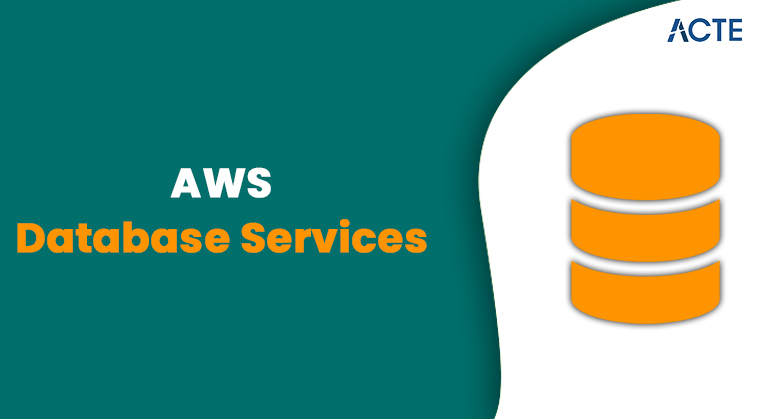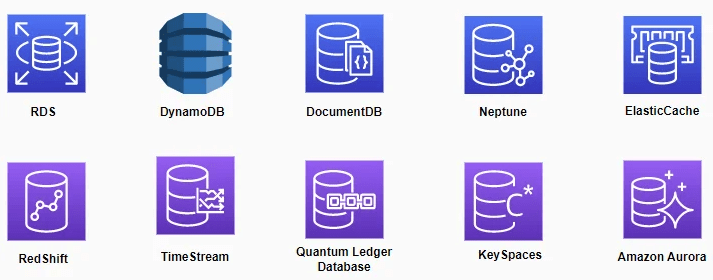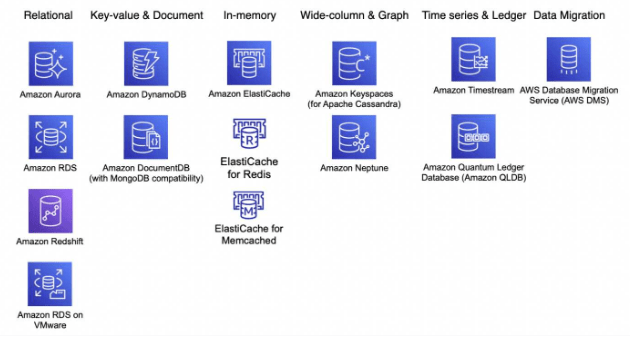
- Introduction to AWS Database Services
- Key Features of AWS Database Services
- Types of AWS Database Services
- Benefits of AWS Database Services
- How AWS Database Services Work
- Comparison of AWS Database Services
- Pricing of AWS Database Services
- Security Features of AWS Database Services
- Use Cases of AWS Database Services
- Conclusion
Introduction to AWS Database Services
AWS (Amazon Web Services) offers a comprehensive suite of managed database services designed to help businesses easily store, manage, and analyze data in the cloud. AWS Database Services cater to a wide range of needs, whether you’re looking for relational databases, NoSQL databases, data warehousing, or in-memory data stores. These services provide high availability, scalability, security, and easy management, making them ideal for businesses of all sizes, as emphasized in Amazon Web Services Training. With over 15 types of database services, AWS gives users flexibility in choosing the correct database based on their application’s requirements, data structure, and use cases. These services are designed to remove the complexity of database management, allowing businesses to focus on innovation and application development rather than administrative overhead.
To Explore AWS in Depth, Check Out Our Comprehensive AWS Course To Gain Insights From Our Experts!
Key Features of AWS Database Services
AWS Database Services have several features that enhance performance, ease of use, and scalability. Some of the key features include:
- Fully Managed: AWS database services handle all the operational tasks, such as backups, patching, and scaling, so you don’t have to worry about managing the infrastructure.
- Scalability: With AWS, you can quickly scale up or down based on your needs. Whether dealing with small-scale applications or large, enterprise-level systems, AWS offers the flexibility to scale your database resources.
- High Availability: AWS database services are built for high availability. Many AWS databases offer multi-AZ (Availability Zone) deployments, ensuring your data is replicated across multiple locations for fault tolerance, a concept also applied in What is AWS Sagemaker for ensuring reliable machine learning workflows.
- Performance: AWS databases are optimized for performance. Services like Amazon RDS, DynamoDB, and Aurora offer high throughput and low-latency processing for applications that need fast and reliable data access.
- Security: Security is a priority in AWS Database Services, with encryption options at rest and in transit, alongside integrated identity and access management (IAM) to control user access.
- Cost-Effectiveness: Pay-as-you-go pricing allows businesses to only pay for the resources they use. AWS offers different pricing models for various database services, making it affordable for small and large companies.
- Provisioning: You start by selecting the database type you need. AWS allows you to provision database instances with a few clicks or API calls. Each service has its configuration.
- Scaling: AWS provides several scaling mechanisms. You can vertically scale your database by increasing resources (CPU, RAM, storage) or horizontally scale by adding more replicas or shards.
- Backup and Recovery: AWS handles automatic backups for most database services, a feature commonly highlighted in AWS Training. For example, Amazon RDS automatically takes snapshots of your data, and Amazon DynamoDB offers continuous backups with point-in-time recovery.
- Security: AWS databases are protected by robust security mechanisms, including data encryption at rest and in transit. You can manage access control using IAM roles and policies.
- Monitoring and Maintenance: AWS provides monitoring tools like Amazon CloudWatch to track the performance and health of your databases. AWS handles software patching, updates, and maintenance automatically, ensuring your database remains secure and up-to-date.
- Encryption: Data is encrypted both at rest and in transit. AWS offers various encryption mechanisms, including AES-256 encryption, and integrates with AWS Key Management Service (KMS) for managing keys.
- Access Control: AWS IAM allows fine-grained access control, enabling you to set permissions at the database, table, or individual record level.
- Audit Logging: Services like Amazon RDS and DynamoDB provide detailed logs of access and actions performed on your database, helping you maintain compliance and track security incidents.
- VPC Integration: AWS databases can be run inside a Virtual Private Cloud (VPC), allowing you to isolate your databases from the public internet for enhanced security.
- Compliance: AWS adheres to various industry standards and compliance certifications, such as HIPAA, PCI-DSS, GDPR, and SOC 2, ensuring that your database services meet stringent security requirements, similar to the governance practices outlined in the Azure Portal Guide to Cloud Management.
- E-Commerce: Amazon RDS and DynamoDB store product catalogs, customer orders, and session data. They are highly available and have low latency.
- IoT: Amazon Timestream is ideal for storing and analyzing time-series data generated by IoT devices, allowing businesses to monitor and respond to real-time events.
- Mobile Applications: DynamoDB is widely used in mobile app development to store user profiles, session information, and application data with low-latency access.
- Data Warehousing: Businesses use Amazon Redshift to perform complex data analytics on large-scale datasets, ideal for business intelligence and reporting.
- Gaming: Amazon ElastiCache speeds up game-related data retrieval, such as storing user sessions and real-time leaderboards.

Types of AWS Database Services
Relational Databases (RDS)
Amazon RDS (Relational Database Service) is a fully managed service that makes it easy to set up, operate, and scale a relational database. It supports several database engines, including MySQL, PostgreSQL, MariaDB, Oracle, and SQL Server.NoSQL Databases
Amazon DynamoDB is a fast and flexible NoSQL database service designed for applications that need single-digit millisecond latency and scalability, much like the efficiency and scalability principles covered in Linux for DevOps. Amazon DocumentDB is a fully managed document database service compatible with MongoDB. It offers scalability and high performance for document-oriented applications.Data Warehousing
Amazon Redshift is a fully managed data warehouse service designed for running complex queries on large-scale datasets, making it ideal for big data analytics.
In-Memory Databases
Amazon ElastiCache provides in-memory caching to improve the performance of web applications. It stores and retrieves data from in-memory data stores like Redis and Memcached.
Graph Databases
Amazon Neptune is a fully managed graph database service that supports property and RDF graphs, making it suitable for applications like social networking, recommendation engines, and fraud detection.
Time Series Databases
Amazon Timestream is a fully managed time series database service for storing and analyzing time-stamped data. It is ideal for IoT applications, monitoring, and real-time analytics.
Are You Interested in Learning More About AWS? Sign Up For Our AWS Course Today!
Benefits of AWS Database Services
AWS Database Services offer several benefits, making them a compelling choice for organizations looking to manage data effectively and securely. Ease of Use is a key advantage, as AWS provides fully managed database services, eliminating the need for businesses to handle maintenance tasks like patching, backups, or scaling. Scalability ensures that databases automatically adjust to application demands through increased storage, compute power, or read replicas. High Availability and Reliability are maintained through multi-AZ deployments, automated backups, and automatic failover, protecting databases from hardware failures, as detailed in the Guide to AWS SDK. Security and Compliance features safeguard sensitive data, including encryption, identity and access management (IAM), and compliance with significant regulations like GDPR and HIPAA. Cost Efficiency is another advantage, as Amazon Web Services operates on a pay-as-you-go model, removing the need for substantial upfront investments while offering flexible pricing tiers for various database types. Additionally, Integrated Services allows AWS databases to work seamlessly with Amazon S3, Amazon EC2, AWS Lambda, and other services, enabling businesses to build sophisticated applications without managing complex infrastructure.
How AWS Database Services Work
AWS Database Services are designed to simplify database management while ensuring that applications perform at scale. Here’s a general overview of how AWS database services work:

Comparison of AWS Database Services
| Service | Use Case | Key Features |
|---|---|---|
| Amazon RDS | General-purpose relational databases | Fully managed, supports MySQL, PostgreSQL, Oracle, SQL Server |
| Amazon DynamoDB | Low-latency, high throughput applications | Managed NoSQL, serverless, automatic scaling—features that can be integrated into workflows managed with Ansible Tower |
| Amazon Redshift | Big data analytics and reporting | High-performance, scalable analytics engine |
| Amazon ElastiCache | Web caching, session stores, real-time applications | Supports Redis and Memcached, in-memory caching |
| Amazon Neptune | Graph-based applications (social networks, fraud detection) | Managed graph database, supports Gremlin and SPARQL queries |
Looking to Master AWS? Discover the AWS Masters Course Available at ACTE Now!
Pricing of AWS Database Services
AWS offers flexible pricing models for its database services, primarily following a pay-as-you-go approach where costs are based on resource usage. Instance Types play a significant role in pricing, as larger instances with more CPU, RAM, and storage incur higher costs. Storage expenses depend on the amount of data stored, especially in services like Amazon RDS, where charges apply to provisioned storage. Data transfer within AWS regions is generally free, but transferring data outside an area, such as the internet, may lead to additional costs, a consideration discussed in Understanding AWS Data Pipeline. Backup and Snapshots also contribute to pricing, as AWS charges for backup storage, including automated backups and manual snapshots in Amazon RDS. Request and Throughput impact the cost of services like Amazon DynamoDB, which bills based on the number of read and write requests or the database’s throughput capacity. Amazon Web Services provides a pricing calculator to estimate expenses that help users forecast costs based on their specific usage and service selection.
Security Features of AWS Database Services
Use Cases of AWS Database Services
AWS Database Services are used across a variety of industries and applications. Some everyday use cases include:
Go Through These AWS Interview Questions & Answer to Excel in Your Upcoming Interview.
Conclusion
AWS Database Services offer a comprehensive and flexible suite of managed tools designed to support the varying needs of modern applications. Whether you’re using traditional relational databases or modern NoSQL solutions, AWS provides scalable, secure, and highly available options. Services like Amazon RDS make it easy to set up, operate, and scale relational databases such as MySQL, PostgreSQL, SQL Server, and Oracle. For NoSQL workloads, Amazon DynamoDB delivers fast and predictable performance with seamless scalability, as explored in AWS Training. AWS also offers purpose-built databases like Amazon Aurora for high-performance applications and Amazon Redshift for data warehousing and analytics. These services are fully managed, reducing administrative overhead by handling tasks such as provisioning, patching, backups, and monitoring. Built-in security features, including encryption, network isolation, and fine-grained access control, help protect your data. With this wide range of database options, AWS empowers businesses to streamline operations, reduce costs, and focus on building innovative and scalable applications without the complexity of traditional database management.





